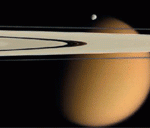 NASA’s Cassini mission celebrated its tenth year last week by releasing images of the solar system’s preening beauty, Saturn, and its fawning entourage of moons and rings. Eagle-eyed researchers spotted “moonlets” plowing through the delicate rings and reported the results in this week’s issue of Nature.
NASA’s Cassini mission celebrated its tenth year last week by releasing images of the solar system’s preening beauty, Saturn, and its fawning entourage of moons and rings. Eagle-eyed researchers spotted “moonlets” plowing through the delicate rings and reported the results in this week’s issue of Nature.
The moonlets measure just 30 to 70 meters across, but most of the debris in the rings measures less than 10 meters, so the moonlets leave a traceable wake. Saturn’s rings vary in thickness from about 100 meters to slightly more than 1 km.
In the image, Epimetheus (116 km across) floats just above Titan (5150 km), the largest of Saturn’s moons. The light-colored streaks in the ring may be caused by moonlets. The dark-colored section in the middle of the ring is the 325-km-wide Encke gap, probably caused by a gravitational resonance.
Cassini has mapped 60% of Titan’s northern hemisphere, which is home to lakes, rivers, and seas of liquid methane and ethane. The southern half is slated to be mapped next.
Originally appeared in Science Magazine as a Random Sample: [html] [pdf]


